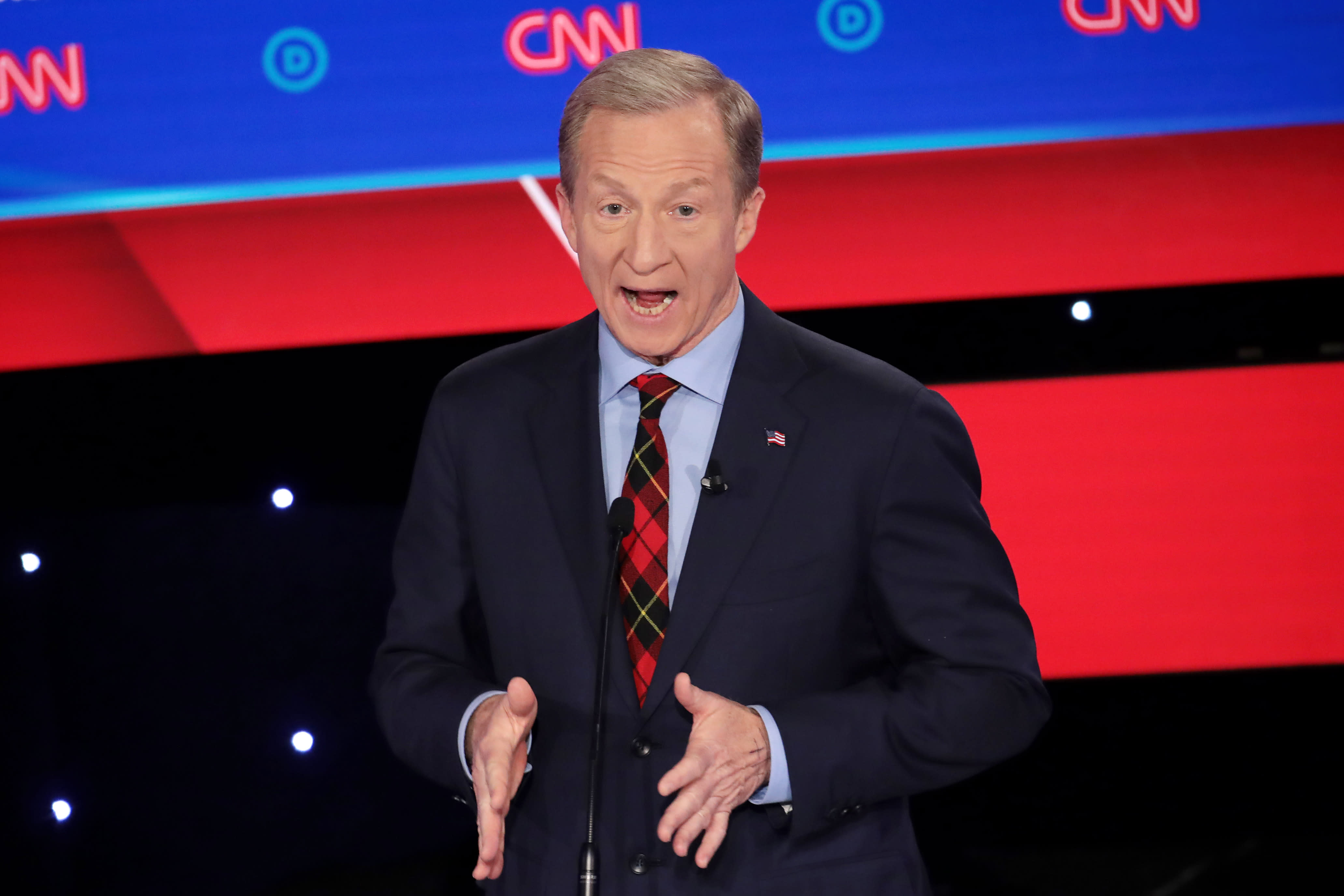Tom Steyer speaks during the Democratic presidential primary debate at Drake University on January 14, 2020 in Des Moines, Iowa. Six candidates out of the field qualified for the first Democratic presidential primary debate of 2020, hosted by CNN and the Des Moines Register.
Scott Olson | Getty Images
Billionaire Tom Steyer is calling for a 10% tax cut for families — and he plans to pay for it by raising levies on investment portfolios.
The Democratic contender for president released the details of his tax plan on Thursday.
Families earning less than $250,000, as well as individuals with income under $200,000 would receive a 10% cut to their current tax rate under this proposal, Steyer said. This would benefit 95% of Americans, he said.
Steyer is also calling for enhancements to a pair of tax credits for working families: the earned income tax credit and the child tax credit.
More from Personal Finance:
Six tactics to avoid money fights with your teen
A surprise health insurance tax is around the corner
The 5 best states for retirees in 2020
The candidate proposes paying for these and other adjustments by raising capital gains taxes — which can be as much as 20% for investments you’ve held at least a year — to match the rates on ordinary income, which currently tops out at 37%.
He has also proposed raising the top marginal income tax rate to 39.6%, from 37%.
Steyer isn’t the only presidential candidate to propose increasing capital gains rates to help broaden programs for families.
Former vice president Joe Biden, Sen. Bernie Sanders (I-Vt.) and Sen. Elizabeth Warren (D-Mass.) have all proposed taxing capital gains at the same rate as ordinary income for high-income households.
Both Sanders and Warren want to use that revenue to help fund Medicare for All. Biden pitched his rate hike to help shore up the Affordable Care Act.
In addition, Steyer, who has a reported net worth of $1.6 billion, is calling for a wealth tax on those with at least $32 million in total net worth, starting at 1%.
The levy rises to 2% for those with at least $1 billion.
Steyer estimates his wealth tax will raise $1.7 trillion in the first 10 years.
“I think one of the questions is, ‘Will this be enough to support everything in the plan?'” said Garrett Watson, special projects manager at the Washington, D.C.-based Tax Foundation.
Tax credit expansion
ArtisticCaptures
“There are two levers in the federal income tax code that are used quite efficiently to help low-income workers and families with children,” said Elaine Maag, principal research associate at the Urban-Brookings Tax Policy Center.
“They are the earned income tax credit and the child tax credit.”
Currently, the child tax credit is $2,000 for each child under the age of 17, and up to $1,400 of it is refundable.
Steyer’s proposal would make the child tax credit fully refundable, plus add in a $1,000 credit for kids under age 6.
Meanwhile, the earned income tax credit is aimed at low- to middle-income workers.
Currently, single taxpayers with no children are phased out of the credit once their adjusted gross income (AGI) exceeds $15,570 ($21,370 for married-filing-jointly).
Households with children are subject to higher AGI thresholds: A taxpayer with three children who is filing as head of household can qualify for this credit with an AGI of up to $50,162 ($55,952 if married and filing jointly).
Steyer is proposing to increase the amount of the credit by about 25% for low- to moderate-income households with children, as well as boosting the amount filers with no children can receive.
For instance, a single filer with no children and an AGI of $15,000 would save $1,500 under the plan, Steyer said.
Meanwhile, a married couple with two kids and income of $100,000 would save $800.
“Almost all parents with children get the child tax credit, so if you increase it by much at all, it starts to add up rather quickly,” said Maag.
Proposed tax hikes
(L-R) Democratic presidential hopefuls billionaire-philanthropist Tom Steyer, Massachusetts Senator Elizabeth Warren, Former Vice President Joe Biden, Vermont Senator Bernie Sanders, Mayor of South Bend, Indiana, Pete Buttigieg and Minnesota Senator Amy Klobuchar stand on stage ahead of the seventh Democratic primary debate of the 2020 presidential campaign season co-hosted by CNN and the Des Moines Register at the Drake University campus in Des Moines, Iowa on January 14, 2020.
Kerem Yucel | AFP | Getty Images
Meanwhile, higher tax rates on capital gains may encourage investors to sit on their assets for years at a time, said Watson.
When those investors die, heirs get a “step-up in basis,” meaning they inherit the asset at market value as of the day of death and they can sell it for little to no capital gains tax.
“People pay capital gains rates when they sell, so they might be more likely to hold onto the asset,” said Watson. “A revenue raiser would be to repeal the step-up in basis.”
Biden’s tax proposal includes a repeal of the step-up in basis.
A so-called mark-to-market tax, where investors are taxed even if they continue to hold an asset, might also be a more effective way to raise revenue, Watson said.
